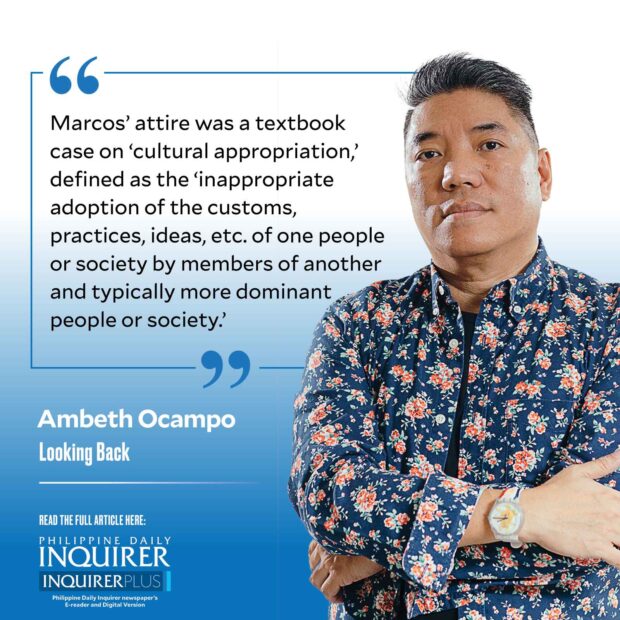Fashion and history clashed in the past week: first, when Beauty Gonzalez wore jewelry repurposed from pre-Spanish Philippine gold artifacts to the 2023 GMA ball; second, when Sen. Imee Marcos wore Cordillera textiles, ornaments, and tattoos to the 2023 State of the Nation Address (Sona).
Both women and their fashion statements reaped both scorn and praise, so they got the attention and publicity they wanted. Issues of cultural appropriation and cultural heritage at risk brought on by their fashion statements deserve serious discussion.
To move forward, however, we must throw away the soundbytes meant to draw raw, visceral, gut reactions that distract us from the issues. Trending online discourse is driven by negative and inane comments that generate heat rather than light.
Marcos’ take, translated from the original Filipino, stated that: “As a ‘Lagunawa’ or ‘Daughter of Kalinga,’ I chose to wear traditional Cordillera attire to [Sona 2023] as a tribute to the colorful culture of our indigenous tribes … even the [temporary henna] tattoos on my body have meaning, like the sun and moon that I chose as these symbolize my selfless service and dedication to help people, and the lizard on my arm symbolizes the renewal of everyone and the establishment of an endless conviction and value to society.”
Marcos’ attire was a textbook case on “cultural appropriation,” defined as the “inappropriate adoption of the customs, practices, ideas, etc. of one people or society by members of another and typically more dominant people or society.” In a statement, Siklab Philippine Indigenous Youth Network declared that Marcos’ fashion statement was an insult to indigenous peoples, that she wore their clothing improperly and misused tattoos that symbolized courage and honor.
Instead of focusing on the plight of indigenous peoples, it degenerated into nasty comments on the senator’s cosmetically enhanced features. Former beauty queen Aurora Pijuan Manotoc had the last word: “… I won’t recognize her even if I run her over [on] Edsa … ” Both Pijuan and Marcos are ex-wives of sportsman Tommy Manotoc.
Beauty Gonzalez’s take: “My look for [GMA Gala 2023] is an appreciation for Philippine ancestral gold. My centuries-old gold neck piece and earrings are excavated eye and mouth covers from distant places like Butuan and Surigao.”
This is not new. Celia Molano and the late Arturo de Santos, Ramon Villegas, and Arturo Luz repurposed precolonial Philippine gold ornaments into modern wearable jewelry. When I commented on the gold jewelry dripping from a society matron bedecked like a Christmas tree in the 1990s, her reply was, “Oye, hijo, anyone can have diamonds and emeralds in Cartier or Harry Winston pieces but mine is rarer!” I wanted to tell her that the gold disks she had as earrings might have been precolonial penis implements! Gonzalez wore pieces from death masks, thin beaten gold that covered the eyes and mouths of the dead as they traveled to the afterlife. Many well-appointed homes have vitrines with small delicate Chinese porcelain from the Song (960-1279) and Yuan (1279-1368) periods excavated from the Philippines. These are also grave furniture or “pabaon” to the afterlife.
Marian Pastor Roces called out Gonzalez: “Someone tell this woman that the orifice covers she is paying ‘homage’ to are grave robber stuff. Because if these were legally excavated, the pieces would belong to the National Museum or the Bangko Sentral [ng Pilipinas] (BSP).”
The BSP gold collection are surface finds, acquired largely from runners and dealers. These artifacts were not legally nor archaeologically excavated. Only the National Museum and excavations funded by Leandro and Cecilia Locsin have provenanced gold pieces.
The BSP collection was a double-edged sword. On one hand, it fueled the 1981 Surigao gold rush resulting from gold pieces accidentally found during road construction. By buying up the gold pieces instead of funding a proper intervention and excavation by the National Museum, the BSP encouraged the looting of the archaeological site that resulted in the loss of associated material that provides historical context.
On the positive side, the BSP saved these gold objects from ending up in inaccessible private collections or worse, sold for gold value and melted into bullion. On display in the BSP and Ayala Museum gold collections comprise only 30 percent of what once was.
Fashion started the conversation, we should keep it going.
—————-
Comments are welcome at aocampo@ateneo.edu
